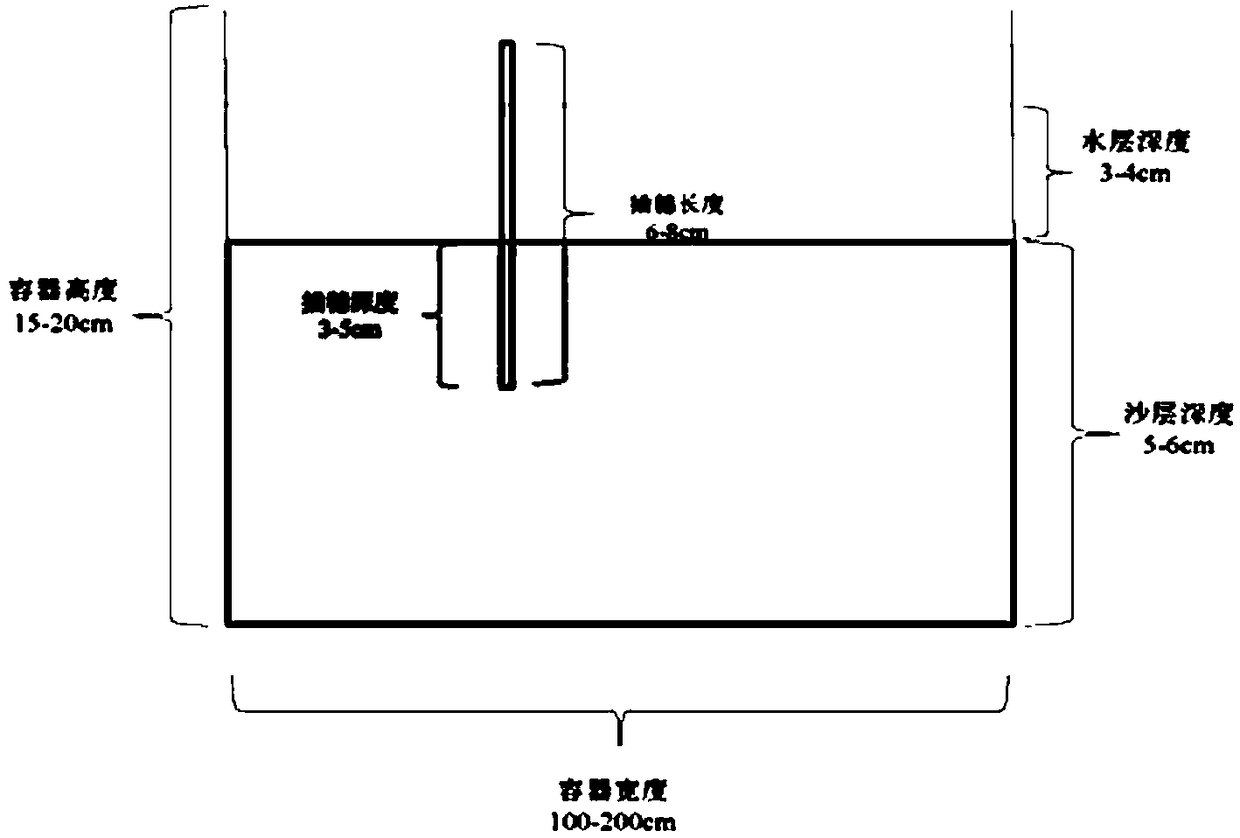Method for improving rooting rate of cutting of salix chaenomeloides
A technology of rooting rate and cutting, applied in the fields of botanical equipment and methods, horticulture, application, etc., can solve the problems of short storage time of seed vigor, inability to fix excellent characters, large variation of seedling shape, etc., to overcome the low rooting rate of cuttings, The effect of improving the survival rate of seedlings and the simplicity of seedling facilities
- Summary
- Abstract
- Description
- Claims
- Application Information
AI Technical Summary
Problems solved by technology
Method used
Image
Examples
Embodiment 1
[0044] Step 1. Slotting bed preparation: Choose a water-proof container with a width of 2m, a depth of 15cm, and an unlimited length for the slotting machine. Spread 5cm of fine river sand on the bottom of the slotting bed, and then put in clear water to a depth of 3cm to form a water bed.
[0045] Step 2, selection of seedlings: select the branches on the 1-year-old seedlings of the excellent variety of river willow, with a diameter of 0.4-1.5cm, the seedlings or branches are strong and free of diseases and insect pests, and the side buds are full.
[0046] Step 3, cutting cuttings: cut the seed strips short to make cuttings, each cutting is 6.0-8.0cm long. The upper part of the cuttings is truncated, retaining 1 leaf bud, the bottom is truncated or obliquely cut, and the cut is smooth.
[0047] Step 4. Cutting: Insert the cuttings of the river willow into the fine river sand of the water bed for 3-5cm, and the terminal buds shall be exposed to the water surface. The cuttin...
Embodiment 2
[0052] Step 1. Slotting bed preparation: Choose a water-proof container with a width of 2m, a depth of 20cm, and an unlimited length as the slotting machine. In the greenhouse, dig soil directly to build a low bed, with a width of 2m, a depth of 20cm, and any length, and a plastic film is used to pad the bottom and side of the bed to prevent water seepage. Spread 4cm of fine river sand on the bottom of the slotting bed, and then put in clear water to a depth of 4cm to form a water bed.
[0053] Step 2, selection of seedlings: choose the branches on the 2-year-old seedlings of the excellent variety of river willow, with a diameter of 0.4-1.5cm. The seedlings or branches are strong and free of diseases and insect pests, and the side buds are full.
[0054] Step 3, cutting cuttings: cut the seed strips short to make cuttings, each cutting is 6.0-8.0cm long. The upper part of the cuttings is truncated, retaining 1 leaf bud, the bottom is truncated or obliquely cut, and the cut is...
Embodiment 3
[0060] Step 1. Slotting bed preparation: Choose a water-proof container with a width of 1m, a depth of 15cm, and an unlimited length for the slotting machine. Spread 3cm of fine river sand on the bottom of the slotting bed, and then put in clear water to a depth of 3cm to form a water bed.
[0061] Step 2, selection of seedlings: choose the branches on the 2-year-old seedlings of the excellent variety of river willow, with a diameter of 0.4-1.5cm. The seedlings or branches are strong and free of diseases and insect pests, and the side buds are full.
[0062] Step 3, cutting cuttings: cut the seed strips short to make cuttings, each cutting is 6.0-8.0cm long. The upper part of the cuttings is truncated, retaining 1 leaf bud, the bottom is truncated or obliquely cut, and the cut is smooth.
[0063] Step 4. Cutting: Insert the cuttings of the river willow into the fine river sand of the water bed for 3-5cm, and the terminal buds shall be exposed to the water surface. The cuttin...
PUM
 Login to View More
Login to View More Abstract
Description
Claims
Application Information
 Login to View More
Login to View More - R&D
- Intellectual Property
- Life Sciences
- Materials
- Tech Scout
- Unparalleled Data Quality
- Higher Quality Content
- 60% Fewer Hallucinations
Browse by: Latest US Patents, China's latest patents, Technical Efficacy Thesaurus, Application Domain, Technology Topic, Popular Technical Reports.
© 2025 PatSnap. All rights reserved.Legal|Privacy policy|Modern Slavery Act Transparency Statement|Sitemap|About US| Contact US: help@patsnap.com


